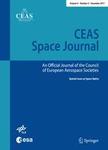版权所有:内蒙古大学图书馆 技术提供:维普资讯• 智图
内蒙古自治区呼和浩特市赛罕区大学西街235号 邮编: 010021

作者机构:European Space Agcy ESA ESTEC GNC AOCS & Pointing Div Noordwijk Netherlands Vitrociset Belgium SRL Noordwijk Netherlands
出 版 物:《CEAS SPACE JOURNAL》 (CEAS空间杂志)
年 卷 期:2022年第14卷第1期
页 面:173-186页
核心收录:
学科分类:08[工学] 0825[工学-航空宇航科学与技术]
主 题:Convex programming Attitude guidance and control Trajectory optimization Comet interceptor
摘 要:This paper introduces an algorithm to perform optimal reorientation of a spacecraft during a high speed flyby mission that maximizes the time a certain target is kept within the field of view of scientific instruments. The method directly handles the nonlinear dynamics of the spacecraft, sun exclusion constraint, torque and momentum limits on the reaction wheels as well as potential faults in these actuators. A sequential convex programming approach was used to reformulate non-convex pointing objectives and other constraints in terms of a series of novel convex cardinality minimization problems. These subproblems were then efficiently solved even on limited hardware resources using convex programming solvers implementing second-order conic constraints. The proposed method was applied to a scenario that involved maximizing the science time for the upcoming Comet Interceptor flyby mission developed by the European Space Agency. Extensive simulation results demonstrate the capability of the approach to generate viable trajectories even in the presence of reaction wheel failures or prior dust particle impacts.